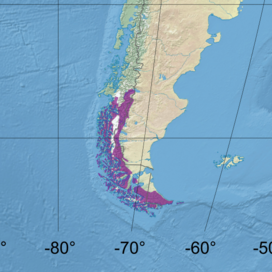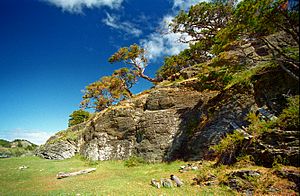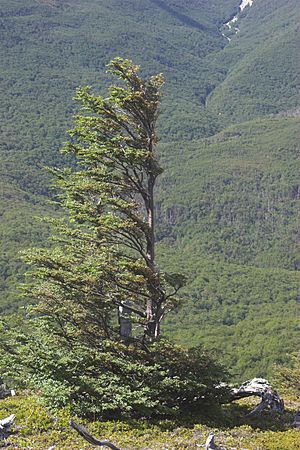Magellanic subpolar forests facts for kids
Quick facts for kids Magellanic subpolar forests |
|
|---|---|

|
|

Ecoregion territory (in purple)
|
|
| Ecology | |
| Realm | Neotropical |
| Biome | temperate broadleaf and mixed forests |
| Borders | Patagonian steppe and Valdivian temperate forests |
| Geography | |
| Area | 150,500 km2 (58,100 sq mi) |
| Countries | Chile and Argentina |
| Conservation | |
| Protected | 69,938 km² (46%) |
The Magellanic subpolar forests are special forests found at the very southern tip of South America. They cover parts of southern Chile and Argentina. These forests are known for being the world's southernmost forests! They are a type of temperate broadleaf and mixed forests, which means they have trees that keep their leaves all year or lose them in winter, and they grow in a mild climate.
Contents
Where are the Magellanic Forests?
These unique forests are located west of the Andes Mountains. The Andes usually run north to south, but near the bottom of South America, they curve towards the east. This area includes the group of islands called Tierra del Fuego.
During the last ice age, this whole region was covered by huge sheets of ice called glaciers. When the glaciers melted, they carved out deep valleys, creating many fjords (narrow sea inlets), islands, and channels. One famous channel is the Strait of Magellan. This strait separates Tierra del Fuego from the main continent. It was named after the explorer Ferdinand Magellan, who sailed through it long ago.
To the north, you'll find the Valdivian temperate forests. These forests are quite similar to the Magellanic ones in terms of plants and animals. To the east, the land becomes much drier. This is where the Patagonia grasslands are, which are in the "rain shadow" of the mountains. This means the mountains block the rain from reaching them.
The Climate of the Magellanic Forests
The Andes and Fuegian mountains play a big role in the climate here. They block the wet winds coming from the west, causing a lot of rain to fall. This creates a temperate rain forest environment.
The ocean also keeps the area cool and wet. The cold Humboldt Current flows up the west coast of South America, and the cold Antarctic Circumpolar Current flows around the bottom of the world. These currents help keep temperatures from getting too hot or too cold.
It's often cool and wet, with average yearly temperatures ranging from about 6°C in the north to 3°C in the south. Rainfall can be very high in the west, up to 4000 mm per year, but much less in the east. Snow can even fall in summer! Fog is very common, and strong winds are a big feature of this region. These winds are so powerful that they can twist and bend trees into unusual shapes, often called "flag trees" because they look like flags blowing in the wind.
Plants of the Magellanic Forests
The Magellanic subpolar forests are a special home for what scientists call the Antarctic flora. This means many plant families found here are also found in other southern lands like New Zealand, Tasmania, and Australia. A very common tree here is the southern beech (Nothofagus). Different types of Nothofagus trees, like N. betuloides, N. antarctica, and N. pumilio, are the most common trees in this ecoregion.
These forests don't have as many different kinds of plants as the warmer Valdivian forests. This is because the climate is colder, and the area was covered by glaciers not too long ago. The glaciers pushed the forests far north. About 10,000 years ago, when the climate warmed and the glaciers melted, the forests slowly grew back.
The Magellanic ecoregion has three main types of plant areas:
- the Magellanic moorland
- the evergreen Magellanic rainforest
- the deciduous Magellanic forest
Magellanic Moorland
The Magellanic moorland is found on the western side of the region, closest to the ocean. This area gets a lot of rain (around 5000 mm per year) and has cool temperatures, strong winds, and thin, rocky soil that doesn't drain well. Most of the moorland is made up of low-growing plants like small shrubs, grasses, and mosses. These plants can form thick layers of peat and create boggy areas. In places that are more protected from the wind, you might find small groups of evergreen trees like Nothofagus betuloides, Drimys winteri, and Pilgerodendron uviferum.
Evergreen Magellanic Rainforest
Moving a bit further from the ocean, where there's less wind and rain, the moorland changes into the evergreen Magellanic rainforest. This forest is mostly made up of Nothofagus betuloides. Other evergreen trees like Drimys winteri and Pilgerodendron uviferum are also common. Sometimes, you'll see Embothrium coccineum and Maytenus magellanica. In older, more established parts of the forest, there can be many different kinds of shrubs growing beneath the trees. In very exposed or rocky areas, you might still find patches of deciduous Nothofagus antarctica and the plants typical of the moorland.
Deciduous Magellanic Forest
As you go even further east, the rainfall decreases. Here, Nothofagus betuloides becomes less common, and it mixes with deciduous trees like Nothofagus pumilio. This is the start of the deciduous forest. The Magellanic deciduous forest is mostly made up of Nothofagus pumilio and Nothofagus antarctica. When you reach the very dry areas east of the mountains, the forests disappear completely and turn into the Patagonian grasslands.
In open areas, you can find some tasty wild fruits. These include the Chilean strawberry (Fragaria chiloensis) and calafate (Berberis buxifolia). These fruits were an important food source for the native people who used to live here.
These forests are amazing because they can handle very cold summers (with average temperatures around 9°C at sea level) and strong subpolar winds. Because of these tough qualities, trees from the Magellanic forests have been planted in other parts of the world with similar harsh conditions, like the Faroe Islands. Trees from Tierra del Fuego, such as Drimys winteri, Nothofagus antarctica, Nothofagus pumilio, and Nothofagus betuloides, have grown well in the Faroe Islands, often better than trees from northern Europe.
Animals of the Magellanic Forests
The Magellanic subpolar forests are home to many interesting animals.
Mammals
One special mammal is the southern pudú (Pudu puda). It's the world's smallest deer, standing only about 35–45 cm tall at the shoulder. Other animals you might find include the cougar (Puma concolor), which is a large wild cat, and the endangered southern river otter (Lontra provocax).
Some small rodents that live only in this region include the Patagonian mara, which looks a bit like a rabbit, the long-clawed mole mouse, and the viscacha, another small rodent with a long, bushy tail.
Birds
Many native bird species live here. These include the Magellanic woodpecker (Campephilus magellanicus), the Patagonian sierra-finch (Phrygilus patagonicus), the Patagonian mockingbird (Mimus patagonicus), and the huge Andean condor (Vultur gryphus).
The rich coastal waters and many rocky islands near the Magellanic forests are also home to lots of seabirds. You can see albatrosses, auks, gulls, terns, and penguins here.
Protected Areas
A large part of the Magellanic subpolar forests is protected. About 46% of this ecoregion, which is 69,938 square kilometers, is part of protected areas. This helps keep these unique forests safe for the future.
Protected Areas in Argentina
Protected Areas in Chile
- Alberto de Agostini National Park
- Bernardo O'Higgins National Park
- Cabo de Hornos National Park
- Katalalixar National Reserve
- Kawésqar National Park
- Patagonia National Park
- Torres del Paine National Park
See also
 In Spanish: Bosque magallánico para niños
In Spanish: Bosque magallánico para niños



